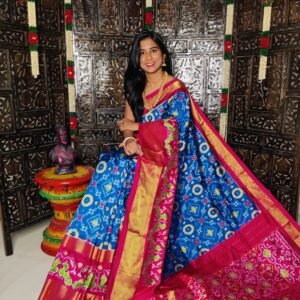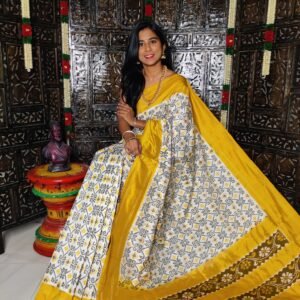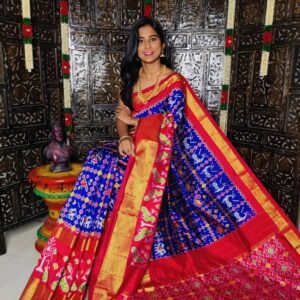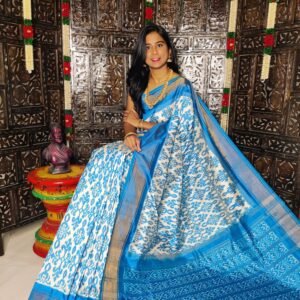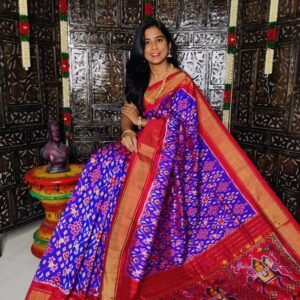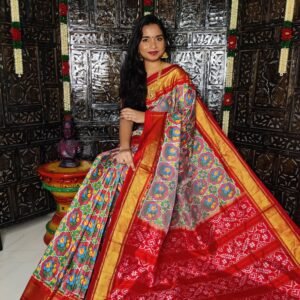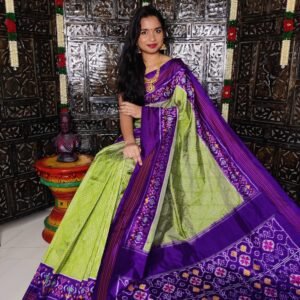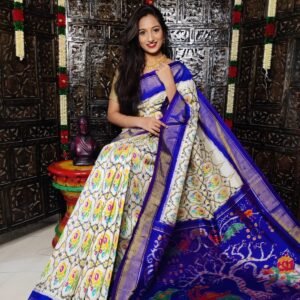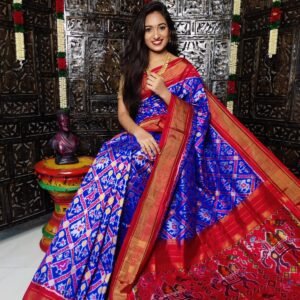- Double Ikkat Weaving Technique: Pochampally sarees are woven using the double ikkat technique, where both the warp and weft threads are resist-dyed before weaving. This results in precise alignment of patterns on both sides of the fabric.
- Intricate Geometric Patterns: Pochampally sarees are known for their intricate geometric patterns and motifs. Look for precise geometric shapes such as squares, diamonds, and rectangles, often arranged in symmetrical designs.
- Vibrant Colors: Pochampally sarees typically feature bold and vibrant colors. Traditional color combinations include contrasting hues like red and black, blue and yellow, or green and maroon. The colors are often vivid and saturated.
- Distinctive Borders: Pochampally sarees often have distinctive borders that complement the main body of the saree. These borders may feature additional geometric patterns or contrasting colors that enhance the overall aesthetic appeal.
- Handcrafted Quality: Authentic Pochampally sarees are handcrafted by skilled artisans, resulting in high-quality craftsmanship. Look for even weaving, consistent patterns, and fine detailing throughout the saree.
- Traditional Motifs: Pochampally sarees may also feature traditional motifs inspired by nature, mythology, or cultural symbols. These motifs are intricately woven into the fabric and contribute to the overall beauty of the saree.
- Distinctive Pallu: The pallu, or the decorative end piece of the saree that drapes over the shoulder, often features elaborate designs in Pochampally sarees. Pay attention to the intricacy of the patterns and the symmetry of the design.
- Authenticity Markers: Some Pochampally sarees may come with authenticity markers such as tags, labels, or certificates issued by recognized authorities or cooperatives. These markers can help verify the authenticity of the saree and its origin.
-
Double Ikkat Sarees
Pure Pochampally Double Ikkat Silk Saree Purple Color
Original price was: ₹15,000.00.₹10,999.00Current price is: ₹10,999.00. Add to cart27%Pure Pochampally Double Ikkat Silk Saree Purple Color
Original price was: ₹15,000.00.₹10,999.00Current price is: ₹10,999.00. -
Double Ikkat Sarees
Pure Pochampally Double Ikkat Silk Saree Blue and Red with Zari
Original price was: ₹15,000.00.₹10,999.00Current price is: ₹10,999.00. Add to cart27%Pure Pochampally Double Ikkat Silk Saree Blue and Red with Zari
Original price was: ₹15,000.00.₹10,999.00Current price is: ₹10,999.00. -
Double Ikkat Sarees
Pure Pochampally Double Ikkat Silk Saree White and Yellow
Original price was: ₹15,000.00.₹10,999.00Current price is: ₹10,999.00. Add to cart27%Pure Pochampally Double Ikkat Silk Saree White and Yellow
Original price was: ₹15,000.00.₹10,999.00Current price is: ₹10,999.00. -
Double Ikkat Sarees
Pure Pochampally Double Ikkat Silk Saree Dark Blue and Red
Original price was: ₹15,000.00.₹10,999.00Current price is: ₹10,999.00. Add to cart27%Pure Pochampally Double Ikkat Silk Saree Dark Blue and Red
Original price was: ₹15,000.00.₹10,999.00Current price is: ₹10,999.00. -
Double Ikkat Sarees
Pure Pochampally Ikkat Silk Saree Cream and Sky Blue
Original price was: ₹15,000.00.₹10,999.00Current price is: ₹10,999.00. Add to cart27%Pure Pochampally Ikkat Silk Saree Cream and Sky Blue
Original price was: ₹15,000.00.₹10,999.00Current price is: ₹10,999.00. -
Double Ikkat Sarees
Pure Pochampally Ikkat Silk Saree Blue and Red with Blouse
Original price was: ₹15,000.00.₹10,999.00Current price is: ₹10,999.00. Add to cart27%Pure Pochampally Ikkat Silk Saree Blue and Red with Blouse
Original price was: ₹15,000.00.₹10,999.00Current price is: ₹10,999.00. -
Double Ikkat Sarees
Pure Pochampally Ikkat Silk Saree White Red
Original price was: ₹15,000.00.₹11,999.00Current price is: ₹11,999.00. Add to cart20%Pure Pochampally Ikkat Silk Saree White Red
Original price was: ₹15,000.00.₹11,999.00Current price is: ₹11,999.00. -
Pochampally Ikat Silk Sarees
Pure Pochampally Ikkat Silk Saree Green Red
Original price was: ₹15,000.00.₹11,999.00Current price is: ₹11,999.00. Add to cart20%Pure Pochampally Ikkat Silk Saree Green Red
Original price was: ₹15,000.00.₹11,999.00Current price is: ₹11,999.00. -
Pochampally Ikat Silk Sarees
Pure Pochampally Ikkat Silk Saree Parrot Green Purple Blue
Original price was: ₹15,000.00.₹9,999.00Current price is: ₹9,999.00. Add to cart33%Pure Pochampally Ikkat Silk Saree Parrot Green Purple Blue
Original price was: ₹15,000.00.₹9,999.00Current price is: ₹9,999.00. -
Double Ikkat Sarees
Pure Pochampally Ikkat Silk Saree Full Red
Original price was: ₹15,000.00.₹9,999.00Current price is: ₹9,999.00. Add to cart33%Pure Pochampally Ikkat Silk Saree Full Red
Original price was: ₹15,000.00.₹9,999.00Current price is: ₹9,999.00. -
Double Ikkat Sarees
Pure Pochampally Ikkat Silk Saree Cream and Dark Blue
Original price was: ₹18,000.00.₹10,999.00Current price is: ₹10,999.00. Add to cart39%Pure Pochampally Ikkat Silk Saree Cream and Dark Blue
Original price was: ₹18,000.00.₹10,999.00Current price is: ₹10,999.00. -
Double Ikkat Sarees
Pure Pochampally Ikkat Silk Saree Blue and Red
Original price was: ₹18,000.00.₹10,999.00Current price is: ₹10,999.00. Add to cart39%Pure Pochampally Ikkat Silk Saree Blue and Red
Original price was: ₹18,000.00.₹10,999.00Current price is: ₹10,999.00.


